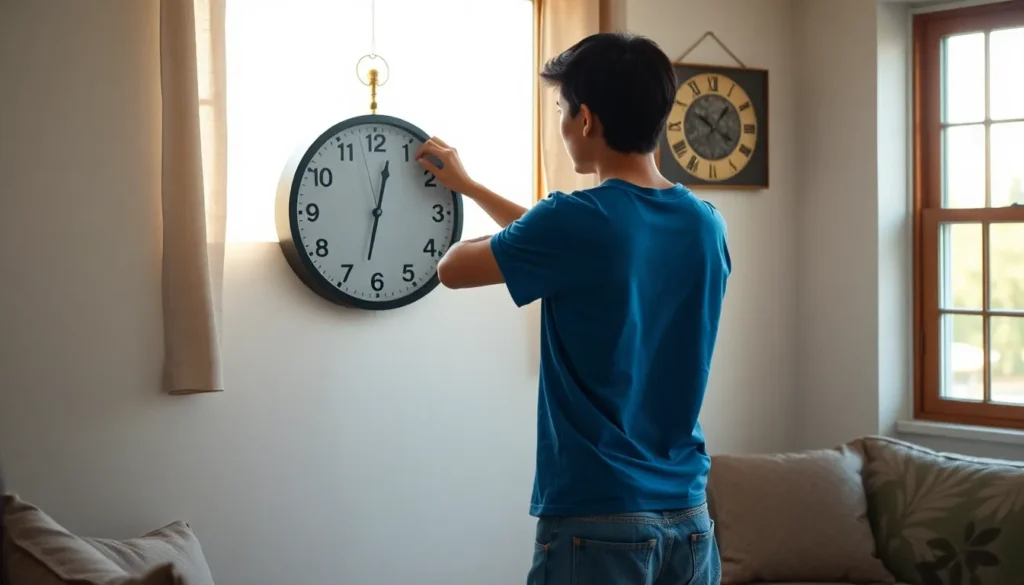Table of Contents
ToggleWhen daylight saving time rolls around, the annual ritual of “uhrenunstellung” begins, and it’s enough to make anyone feel like they’re living in a time warp. This quirky German term refers to the clock adjustment that can throw even the most organized individuals into a frenzy. Who knew setting the clocks forward or back could spark such a mix of excitement and confusion?
What Is Uhrenunstellung?
Uhrenunstellung refers to the annual practice of adjusting clocks, commonly associated with daylight saving time. This term captures the essence of the change in time that occurs twice a year, impacting daily routines. Enthusiasts eagerly anticipate the extra daylight during longer evenings, while others express concern over lost sleep due to the time change.
The transition takes place in March and October in Germany. In March, clocks move forward one hour, while, in October, they fall back, returning to standard time. The rationale behind this practice lies in maximizing sunlight during evening hours, thus saving energy.
Many individuals experience mixed emotions during uhrenunstellung. Some find joy in the longer days and the opportunity for outdoor activities after work. Others deal with the confusion surrounding the time change, struggling to adjust their schedules and internal clocks. Workshops and information campaigns often emerge prior to each transition to help prepare the public.
Statistics show that sleep disturbances can increase during these transitions. Surveys indicate that nearly 40% of people report feeling tired or disoriented in the days following the change. Understanding these effects may encourage better preparedness as the dates approach.
Adhering to uhrenunstellung guidelines remains essential for maintaining synchronization across communities. Public transport schedules, broadcasting times, and business operations all align based on this clock adjustment. It assures that everyone operates on the same time, promoting smoother interactions within society.
Importance Of Uhrenunstellung

Uhrenunstellung plays a vital role in adapting to seasonal changes. This adjustment affects daily schedules, health, and energy consumption.
Benefits Of Proper Time Adjustment
Proper time adjustment enhances productivity and well-being. It allows individuals to enjoy extended daylight, encouraging outdoor activities and exercise. Improved mood often follows the increased exposure to sunlight, reducing symptoms of seasonal affective disorder. Additionally, energy savings result from the effective use of natural light, lowering electricity costs. Public transport operations benefit too, as they rely on synchronized schedules, preventing misunderstandings and delays. Businesses also notice an increase in customer engagement during lighter evenings, thereby boosting sales.
Common Mistakes In Time Adjustment
Common mistakes during time adjustments lead to confusion and inconvenience. Many forget to change clocks in multiple timekeeping devices, creating discrepancies. Some individuals may adjust their schedules too abruptly, resulting in sleep disturbances. Overlooking the change can cause missed appointments or delayed arrivals for work and events. Additionally, not updating automated devices, like alarms and smart home systems, adds to challenges. People often rely solely on their phones, ignoring non-digital clocks, which can still display the previous time.
How To Perform Uhrenunstellung
Adjusting clocks during uhrenunstellung involves a few key steps to ensure accuracy. This process occurs twice a year, so familiarity helps simplify transitions.
Step-By-Step Guide
- Determine the correct time change date. Uhrenunstellung occurs in March and October.
- Set clocks forward one hour in March. This change marks the transition to daylight saving time.
- Set clocks back one hour in October. This adjustment returns to standard time.
- Change all devices. Don’t forget to adjust multiple clocks, like those in cars and microwaves.
- Communicate with others. Remind friends and family about the time change to avoid confusion.
Tools Needed For Uhrenunstellung
Several tools facilitate efficient uhrenunstellung.
- Clock or smartphone. Most people rely on digital devices for accurate timekeeping.
- Calendar reminders. Setting notifications helps remember the change.
- Manual for traditional clocks. Some clocks require specific methods to adjust time.
- Calculator. A simple calculator assists in understanding time differences during transitions.
- Public transport schedules. Checking updated transport times aids in planning.
These tools enhance the uhrenunstellung experience, ensuring smooth transitions and synchronization across daily schedules.
Tips For Effective Uhrenunstellung
Consider setting reminders a week in advance of uhrenunstellung. This approach helps individuals prepare for the time change without the last-minute rush. Adjusting clocks on all devices is crucial. People often forget to change traditional clocks, leading to confusion during the transition.
Use digital clocks or smartphones for accurate timekeeping. These tools automatically update, reducing the chance of errors. Communicating the time change with friends and family ensures everyone is on the same schedule. Missed appointments and misunderstandings can occur if others remain unaware.
Plan activities around the time change to maximize benefits. Engaging in outdoor activities during extended daylight hours enhances mood and promotes exercise. Keeping an eye on updated public transport schedules minimizes delays and disruptions. Many transportation services adjust their timetables around the time changes.
Allow for adjustments in daily routines after uhrenunstellung. Gradually shifting sleep schedules can alleviate potential sleep disruptions. Consider avoiding stimulants like caffeine close to bedtime on the days surrounding the time changes.
Engage in local workshops or information sessions about uhrenunstellung. Communities often organize these events to educate residents and share helpful tips. Reviewing resources focusing on seasonal changes can also provide valuable insights.
Uhrenunstellung plays a vital role in adapting to seasonal changes and optimizing daily life. While it brings excitement for longer days and outdoor activities it also poses challenges like sleep disturbances and scheduling confusion. By following best practices for time adjustment and utilizing helpful tools individuals can navigate this annual event with ease.
Engaging in community discussions and workshops can further enhance understanding and preparation. Embracing the benefits of uhrenunstellung not only improves personal well-being but also fosters synchronization within communities. As society continues to adapt to these changes it’s essential to stay informed and prepared for the clock adjustments ahead.



